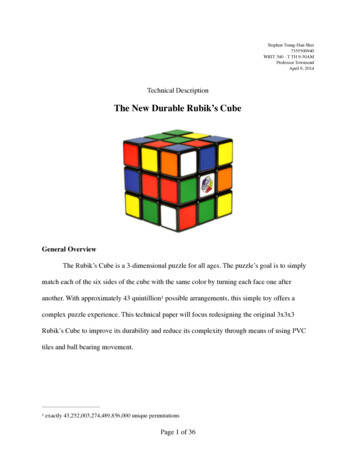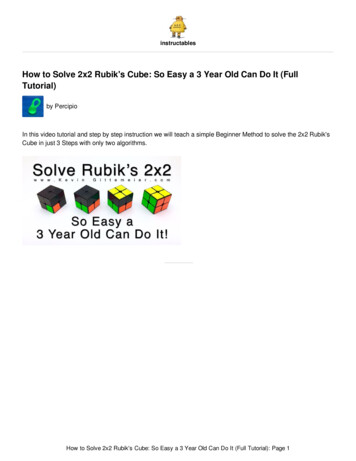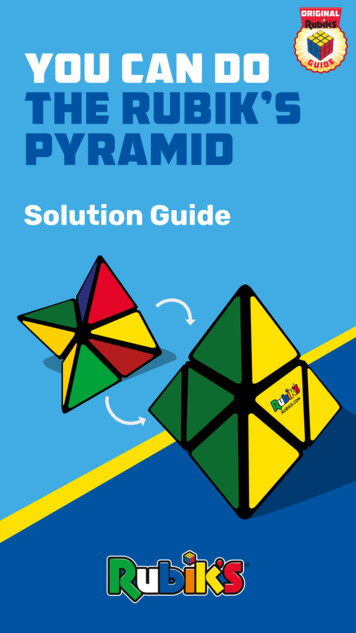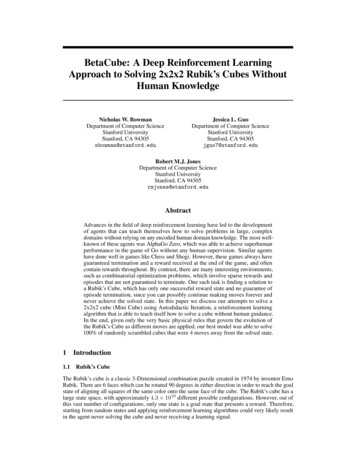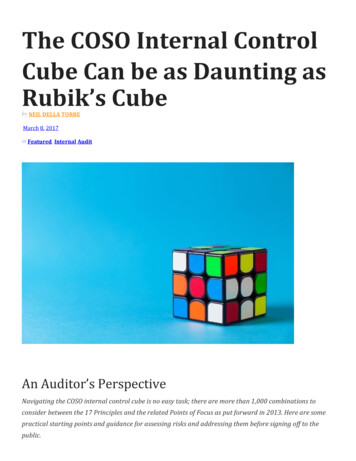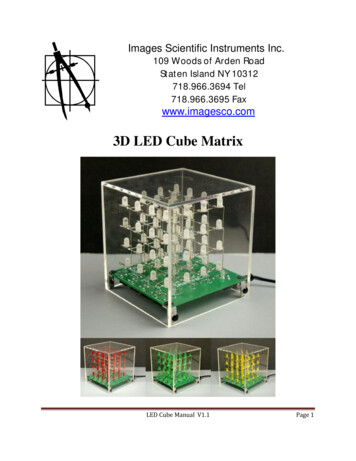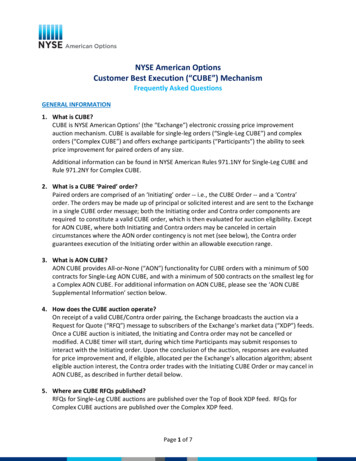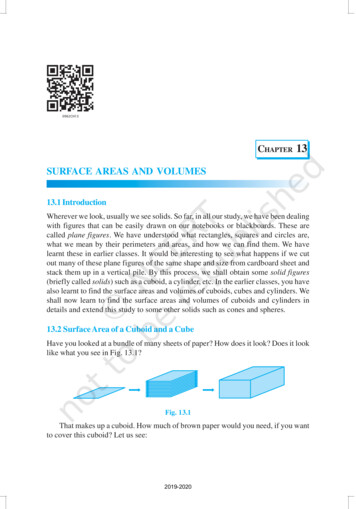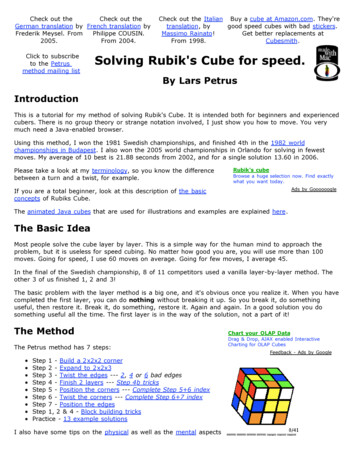
Transcription
Check out theCheck out theGerman translation by French translation byFrederik Meysel. FromPhilippe COUSIN.2005.From 2004.Click to subscribeto the Petrusmethod mailing listCheck out the Italian Buy a cube at Amazon.com. They'retranslation, bygood speed cubes with bad stickers.Massimo Rainato!Get better replacements atFrom 1998.Cubesmith.Solving Rubik's Cube for speed.By Lars PetrusIntroductionThis is a tutorial for my method of solving Rubik's Cube. It is intended both for beginners and experiencedcubers. There is no group theory or strange notation involved, I just show you how to move. You verymuch need a Java-enabled browser.Using this method, I won the 1981 Swedish championships, and finished 4th in the 1982 worldchampionships in Budapest. I also won the 2005 world championships in Orlando for solving in fewestmoves. My average of 10 best is 21.88 seconds from 2002, and for a single solution 13.60 in 2006.Please take a look at my terminology, so you know the differencebetween a turn and a twist, for example.Rubik's cubeBrowse a huge selection now. Find exactlywhat you want today.Ads by GoooooogleIf you are a total beginner, look at this description of the basicconcepts of Rubiks Cube.The animated Java cubes that are used for illustrations and examples are explained here.The Basic IdeaMost people solve the cube layer by layer. This is a simple way for the human mind to approach theproblem, but it is useless for speed cubing. No matter how good you are, you will use more than 100moves. Going for speed, I use 60 moves on average. Going for few moves, I average 45.In the final of the Swedish championship, 8 of 11 competitors used a vanilla layer-by-layer method. Theother 3 of us finished 1, 2 and 3!The basic problem with the layer method is a big one, and it's obvious once you realize it. When you havecompleted the first layer, you can do nothing without breaking it up. So you break it, do somethinguseful, then restore it. Break it, do something, restore it. Again and again. In a good solution you dosomething useful all the time. The first layer is in the way of the solution, not a part of it!The MethodThe Petrus method has 7 steps:Step 1 - Build a 2x2x2 cornerStep 2 - Expand to 2x2x3Step 3 - Twist the edges --- 2, 4 or 6 bad edgesStep 4 - Finish 2 layers --- Step 4b tricksStep 5 - Position the corners --- Complete Step 5 6 indexStep 6 - Twist the corners --- Complete Step 6 7 indexStep 7 - Position the edgesStep 1, 2 & 4 - Block building tricksPractice - 13 example solutionsI also have some tips on the physical as well as the mental aspectsChart your OLAP DataDrag & Drop, AJAX enabled InteractiveCharting for OLAP CubesFeedback - Ads by Google
of speed cubing.Click play for a sample solution in 41 turns.You can download the java code for the cubes.TurnTurnTurnTurnStepTurnFun and GamesI made a cube backtracking game.1-5 is step 16-12 is step 212-16 is step 317-29 is step 45 was not needed30-41 is step 6-7, using F4And a java cube you can solve on time.Thanks and Credits.Ads by GoogleSolve Rubik's CubeRubic CubeRubik PuzzleMail me at cube@lar5.comThis page created March 9 1997.Rubik SolutionRubik's Snake
Cube Tutorial » Step 1Step 1 Step 2 Step 3 Step 4 Step 5 Step 6 Step 7 Examples Block buildingStep 1The goal in this step is to build a 2x2x2 block. Or more precisely, to place one corner and its threeadjoining edges in their correct positions, as is done in the cube to the right.BeginnerFor the beginner it is often easiest to pick a corner that you will always start with. This makes it easy tofind the pieces you need. We will use the blue-yellow-orange corner. This means that the three edges arethe blue-orange, the orange-yellow, and the blue-yellow.What if you don't HAVE a blue-yellow-orange corner?That's normal. There are many different color schemes on cubes in the world, so unfortunately, whatevercolors I pick for my site, it will not match most cubes. The method works for any set of colors, obviously,so try to focus on the method, not the particular colors used as examples.First find the 4 pieces you need, and then try to build the 2x2x2. It's not really hard, but it can take awhile if you're a rookie. It's best to try youself for a while, to get a feel for it, but if it still doesn't workout, try following the description below.There are many special cases, but this is the basic way I solve it. Remember, we're trying to join up 1corner, 3 edges and 3 centers.1.2.3.4.5.Pair up the corner with an edge.Pair up another edge with a center.Join the pairs from 1 & 2 to make a 2x2x1 block.Join the remaining edge with the 2 other centers.Put it all together in one final move.The animation shows a concrete example1.2.3.4.5.Pair corner with blue-orange edge. [Turn 1]Pair up blue-yellow edge with orange center. [Turn 2]Join. [Turn 3-4]Blue-yellow edge fitted between blue and yellow center.[Turn 5-7]All done! [Turn 8]IntermediateAfter you can easily do one corner, you should start looking at all 8 corners and choosing to start with theone that is fastest to solve. Normally, one or two are real easy (and some are hard). Picking the easy onemakes quite a difference. It can be a difficult transition to use different colors all the time, but it is worthit. After a while you'll be completely used to it.At competitions, there is normally a 15 second period where you get to look at the cube before timingstarts. This is what you do during that time (though 2-5 seconds are usually enough).Advanced:Try to be aware of where the four pieces are at all times. You should be able to visualise the full step
solution in your mind before starting.Spend a lot of time looking at this step, and you will start seeing 5 moves ahead or more surprisinglyoften.Here are my solutions for 4 random cube positions. When you can choose between 8 corners you shouldget 1-2 less moves on average.You can rotate acubeyourself bygrabbing itwith the mouse.And you can turnsidesby shift- and/orcontrolclicking them.Try it! Now!For more advanced techniques, check out the block building page.Next Step - Go for 2x2x3Ads by GoogleRubik CubeRubic's CubeRubik PuzzleMail me at cube@lar5.comRubik's SnakeRubiks Magic
Cube Tutorial » Step 2Step 1 Step 2 Step 3 Step 4 Step 5 Step 6 Step 7 Examples Block buildingStep 2After step 1, we have a solved part of the cube, and we have three sides that we can move freely, withoutbreaking up what we have accomplished. Not bad!In step 2 we expand what we have to a 2x2x3 block. That is, we add one corner and two edges in to thesolved block.BeginnerChoose one of the three possible corners to expand to. We will use the green-yellow-orange corner, and ofcourse the yellow-green and green-orange edges.This is quite similar to how you work in step 1, join the corner with one of the edges and work from there.When you're familiar with step 1 you should have no problem.But be sure not to break up the 2x2x2 block! You need to be aware where it is at all times. Otherwise it'sback to step 1.IntermediateYou have three corners to choose from. It's important to pick the easiest, just like in step 1.The hardest positions are when a piece is in it's right position, but twisted the wrong way. The easiest wayto deal with that is to just pick another corner to solve!AdvancedThese simple and very useful moves (to the right) took me months to figure out(actually I didn't, someone I taught showed me.), since it involves breaking theholy 2x2x2 block. As an exercise, try to find how to do the the third example cubeabove in 7 moves instead of 9 by breaking the 2x2x2. It's not easy, so here is ahint: First move: turn green layer 1/4 clock wise. Second move breaks the 2x2x2(highlight to show text)Sometimes, the first move of step 3 will be the opposite of the last move in thisphase. So with some foresight you can skip both. Also, while doing the last turn ofstep 2, you can often stop half way, and fix a pair of bad edges midway. See theexamples page for several examples of this.For more advanced techniques, check out the block building page.Next Step - Twist the edges
Ads by GoogleRubik's CubeHay CubesApple CubeMail me at cube@lar5.comClear CubeCrystal Cube
Cube Tutorial » Step 36][2 4Step 1 Step 2 Step 3 Step 4 Step 5 Step 6 Step 7 Examples BlockbuildingStep 3The basic idea of the method is to solve the entire cube from here by just turning the 2 free sides. But ifyou try to do that, you soon discover that some edges are always twisted the wrong way. We call thosethe "bad" edges. We need to fix that before we move on. Step 3 is this fix.Step 3 can seem incomprehensible before you "get" it, but it is really the simplest step in the method.BeginnerIf you don't like the beginner instructions, take a look at the intermediate ones. You may like thatapproach more.Basically, we need to do 2 things in step 3.1. Identify the bad edges.There are 7 edges not part of the 2x2x3. Pick any one of them, say the red/blue one.Using only the 2 free layers (that is, not breaking up the 2x2x3), place it betweenthe red and blue center pieces. If it's twisted right, it's good. Otherwise it's bad.That's all. Make a (mental or on paper) note of it, and check the next edge. Whenchecking the second and later edges, do not try to keep the previous edges in place.It is not only extremely difficult, but also completely unnecessary. Once you know ifan edge is good or bad, you know.2. Turn bad edges into good edges.There are always an even number of bad edges. You can make them good in pairs. The simplest way isthe 3 move sequence shown to the right. Just place two bad edges in the positions of the colored edges,and do it. Check that your edges actually became good the first times, to be sure you're doing it right.Continue until you're sure all edges are good.IntermediateSince we only want to know if an edge would be correctly twisted if it was placed in its correct location,we don't have to waste moves actually moving it there.It is easy to see immediately which edges are mistwisted without moving them. Let's call the colors of thetwo remaining centre pieces A and B (red and white in the illustrations on this page). Ignore everythingexcept the stickers on the (unsolved) edges that are either color A or B.Here are the four rules to remember:1 . An edge in the A layer thatto the center is good.2 . An edge in the A layer thatfrom the center is bad.3 . An edge in the B layer thatto the center is bad.4 . An edge in the B layer thatfrom the center is good.has an A color sticker nexthas an A color sticker awayhas an A color sticker nexthas an A color sticker away
The usual advice applies in step 3 as well: Look ahead, and try to make a good beginning for the nextstep.AdvancedWhy does the move sequence in the animation above work? It's not just a "magic move". You canunderstand it. What happens is [1] one bad edge is flipped when moved to the other layer, [2] anotherbad edge replaces it, and is [3] (un)flipped when the first turn is reversed. Both edges get flipped in theprocess and so become good. Once you understand that, you can figure out several other moves that dothe same thing.I find that way of thinking much easier than just learning all cases by heart. However you want to learnthem, every possible case is given the fastest solution in the links below.2 bad edges 4 bad edges 6 bad edgesNext Step - Finish 2 layersAds by GoogleSolve Rubik's CubeRubic CubeRubik SolutionMail me at cube@lar5.comRubik PuzzleRubik's Snake
Cube Tutorial » Step 4tricks][To 4bStep 1 Step 2 Step 3 Step 4 Step 5 Step 6 Step 7 Examples Block buildingStep 4This is the hardest step, by far.Or put in a more optimistic way, the other steps are pretty damn easy!BeginnerWhat you do in this step is pretty much the same thing that you do in step 1 and 2. But here you haveone hand tied behind your back. You have only two sides you can turn, and halfway through the step youcan't even do many of those moves, since they would destroy what you already built in the step.From the piece perspective, the goal of step 4 is to add 2 corners and 3 edges to the 2x2x3 block, tomake it into a 2x3x3 block (or 2 full layers in other words).You have a choice of two ways to expand, either leaving the red or the white layer for last. In theexamples we will leave red, expanding with the white-green-orange and white-blue-orange corners andthe white-blue, white-green and white-orange edges. We will have 12 of the 20 pieces solved after this.It's best for the beginner to think of this step as two separate steps, 4a and 4b.Step 4aFirst focus on getting one corner and it's two adjacent edges in position. The same techniques you use instep 1 and 2 can be used, but since you can only turn two sides, more manouvering is needed. To do whatyou want, you first have to move the pieces in a position where the desired turns can be made on the twofree sides.Make sure to only turn the two unsolved sides! It can be easy to get lost and start turning other sides.Keep a firm grip around the 2x2x3 with one hand.Note that you now have two completed 2x2x3 blocks! Remember which of them you started with. If youaccidentally start using the other, bad edges will reappear, and you have to go back to Step 3. A firmgrip of the 2x2x3 is at its most important now!Step 4bPutting the final 2 pieces in place without breaking anything is almost claustrophobic (there are a few otheroptions (explained below)). Since you can't break up the "2x2x1" block you created in this 4a, you haveno choices in how to the white side. You're forced to wiggle it back and forth, 1/4 turn all the time. Soyour only degree of freedom is to choose one of three possible turns with the red layer every other turn!
The normal way of doing this is to join the two pieces in the upper layer, and then put the pair in place,as in these examples (which are the continuations of the examples above).A good thing about this step is that its many turns can be done blindingly fast, since we only turn thesame 2 sides all the time, and never need to change grip.IntermediateIf you can place the final corner by itself, it's often good to do so.There are easy ways to put the final edge in position, by very briefly breaking up our previousachievements. For the mirrored positions, almost identical sequences apply. Note that the second one is avariation of Allan from step 7!AdvancedThe worst positions you can get is when the last corner andedge are next to each other, but misaligned (cube to the left).You can untangle the pieces and put them back together usingonly the "beginner" moves. But it is often faster to use aSune . A reverse Sune fixes the case when the corner istwisted the other way.Check out the examples page for a description of the "brokencorner" position, which is pretty common and good to know.As an exercise, try to find how to do the the middle of thethree example cube above in 6 4 moves instead of 10 12.The solution is here to the right, but it's more fun to try tofigure it out yourself.Here are a few less than obvious 4b tricks. There are many more on the Step 4b tricks page!
For more advanced techniques, check out the block building page.Next Step - Position the cornersAds by GoogleRubik CubeRubic's CubeRubik SolutionMail me at cube@lar5.comRubik PuzzleRubik's Snake
Cube Tutorial » Step 5Index][ToStep 1 Step 2 Step 3 Step 4 Step 5 Step 6 Step 7 Examples Block buildingStep 5Now we're at the final layer. Here we do not think as much. We recognise patterns and apply rules.Common mistake: If theedges are not twisted righthere, you have either notdone step 3 correctly, orscrewed up the edges bybreaking the 2x2x3 in step 4.When entering this step, you should have only onelayer remain unsolved, and the edges in it alreadycorrectly twisted ("forming a cross"). In this stepwe will place the top corners correctly, nothingelse. To do this we need a tool that moves the topcorners without twisting the top edges. This tool isNiklas , and you can see it to the right.In the example, don't worry about how the corners get twisted, just note that thetwo white cornes swap position. (Turn 8 is just to align the corners to the centers toshow clearly how the corners move. Niklas is a 7 turn sequence.)BeginnerThese are1/6 of the1/6 of the4/6 of thethe odds:time, the corners will already be correct. You can go to step 6.time, two corners diagonally opposed will have switched positions.time, two adjacent corners will have switched positions.First we need to find which two corners (if any) that have switched positions. That's easy. Just turn thetop layer until two corners are in correct positions. The two others are either correct or need swapping.There are only four positions to check.Niklas will swap the two corners opposite the layer where you make its first move. Two Niklas es willsolve the diagonal case. You can start with any Niklas .You can do this by just looking at the top layer corners, but I find it much easier to turn it so the colorsmatch up with the rest of the cube. You waste a move but gain time.IntermediateThe fast way to check corners that I use is to find two adjacent corners with thesame (non top) color, and move them to the side of that color. If the corners arecorrect, all 4 will be in place. If adjacent corners are switched, two will be correct,and you can see which ones. If diagonal corners are switched, all four corners will beplaced wrong.Example: Start with the red/blue/white one. Red is the top color, so only blue andwhite are interesting. Start with blue. Check if any of the adjacent corners have ablue sticker. If so move those corners to the blue side. If not, do the same for white.Here is a useful move sequence that directly switches two corners diagonally. It is adifferent (and as good) way of doing Eve.Note that Niklas twists the corners in the same way as Sune does, so the same "target" rules apply. ANiklas that hits a target starts with the same turn as a Sune that hits the same target. About half thetime you can avoid one Sune this way.Advanced
For the advanced cuber, the steps 5-7 meld together to one single step of dozens or even hundreds ofspecial cases. To achieve real speed, you need to be able to remember them in a fraction of a second.Below are a few examples. For what to do for each of the 25 different corner cases, check out thecomplete Step 5 6 indexNext Step - Twist the cornersAds by GoogleRubik's CubeHay CubesCuber SoftwareMail me at cube@lar5.comApple CubeClear Cube
Cube Tutorial » Step 6Index][ToStep 1 Step 2 Step 3 Step 4 Step 5 Step 6 Step 7 Examples Block buildingStep 6BeginnerSo far we have the edges twisted right, and the corners placed right. The next stepis twisting the corners right. This can all be done by one simple move sequence seento the right. I call it Sune . It twists three corners, leaving one untwisted. It alsomoves edges, but we don't care about that yet.Step 6 can always be done with 2 Sunes or less. You do need to learn it to use thismethod.To talk about how to use Sune we need to define the concept the Sune 's target.The target of a Sune in the example is the yellow sticker. In words, the target isthe sticker on the corner opposite the side of the first Sune turn that is leftuntwisted. Or in other words, the first turn of a Sune targets the sticker that (a) is on the opposite sidefrom the side of the first turn, and (b) of the two corner stickers there, it targets the one on the side thatis turned up.Once you've understood the target concept, you only have these three rules to keep in mind. If the finallayer is red.with no correct corners, target a red sticker. This leaves one correct corner.with one correct corner, target like the animation on the top of page.with two correct corners, target a non red sticker of an incorrectly twisted corner. This leaves onecorrect corner.Three corners is an impossible position, and four correct corners is of course the solved position.Here are examples of zero, one and two correct corners. The target is yellow, or orange when it's both redand a target.IntermediateDoing Sune backwards and mirror imaged should also be on your repertoire. Which sticker is the targetof a backwards Sune is left as an excercise for the reader.Here are the two most useful other move sequences. The first is a double Sune, and the second is aBruno.
AdvancedYou need to learn a lot of move sequences, and you need to learn to recignize them quickly. Most of thetime there is a move sequence that solves this step directly, without going to step 7.There are only 49 possible position here. Here are solutions to every single one.Next Step - Position the edgesAds by GoogleRubik's CubeHay CubesApple CubeMail me at cube@lar5.comClear CubeCrystal Cube
Cube Tutorial » ExamplesStep 1 Step 2 Step 3 Step 4 Step 5 Step 6 Step 7 Examples Block buildingSolution examples13 annotated solutionsI hope this will provide the kind of understanding that disjointed theory steps can not. Like how I actuallythink when solving, what the considerations are, how much I can and can't see ahead, etc. The positionsare random ones taken from the Sunday competition for the Yahoo Speed Cubing club on Nov 25 2001.This is of course not speed solutions. Each took me several minutes, and I think hard and study the cubevery carefully for each turn. What I did not do was to try out several different options to see which onewould lead to the best solution in the end. It's all based on what I can see and think ahead about whenlooking at a position. Sometimes I did check what alternatives would have resulted in afterwards, as youcan see.You can follow this fairly well by looking at the java cubes. I recommend stepping one turn at the time,and turning the cube around a lot (click and drag on the cube) to see where the pieces are. But the bestway is to get the same position on your own cube, and go through the solutions there. You can do that bystepping backwards from the solved position, but I prefer taking the cube apart and putting it backtogether in the right state.A few observations from doing this page:In the final turn of S2, I always check if I can flip a bad edge before or duringit. About half the time I do. This is something I learned while going for fewmoves, but it's even more useful for speed cubing, since you can see and acton it immediately. You can see this in examples 4, 5, 6, 7, 8, 10 and 12One position that comes up a few times is the one to the right. Let's call it"Broken corner". It's very useful in S4, but also in S1 and S2. It's well worthmemorizing. It's in examples 2 and 4Surprisingly, for 7 of the 13, I solve S1 S2 in one go, instead of doing S1 andS2 separately. For most of them I didn't do that because it looked so good, butbecause the S1 situation looked so bad. Still the S1 2 solutions averaged 9.2 moves vs 11.5 for thenormal cases, even though they started out from a worse position. Maybe that's coincidence. But Idoubt it. When speeding I don't do nearly as much S1 2 starts. They're often far too complicated toplan out in 15 seconds.Acronyms etc:S1, S2. Step 1, Step 2T1-7 Turn 1-7YB edge Yellow-Blue edgeBWO corner Blue-White-Orange cornerRY/B pair Red-Yellow edge and Red-Yellow-Blue corner[P13/3] The perfect solution is 13 turns, and would save 3 turns. I don't use it since I don't know it.T16 When I merge the final turn(s) of one step with the first in the next, I indicate that with blue turncounters. I hope it's not too confusing that some steps never seem to get completed. They are complete inmy head!Example 1T1-7. S1. Several 7 turn corners available. Icould easily start with another.T8-10. S2.The BWO corner is the obviouschoice, but BYR is also excellent.T11-15. S3. 4 bad edges. It's tempting to tryExample 2T1-4. S1. The existing BW/O pair makes thisthe obvious start.
to preserve the RY/B and/or OG/Y pairs, butit's rarely worth it. I just go straight for thebad edges.T16-24. S4.A simple S4 with no real choicesexcept in T21, where you can pick either of 2options. The other leads to a 44 move solutionthe way I usually do it.T25 makes it easier to see the corners.[P13/3]T26-33 S5 6 is a fundamental move to solveS5-6 for this corner configT33-41 S7 Arne (A2)T5-10. S2. The BYO corner is a little easierthan the other twoT11-15. S3. There are 2 ways to fix thesebad edges in 5 moves. They look equally goodto me. I pick one on random.T16-29. S4. Nothing too obvious here, so Igo for the GOW "broken corner".T30 makes it easier to see the corners.T31-40 S6 7. (no S5) Bruno (G4)Example 3T1-8. S1 2 The RY/B pair gives an obviousstarting point. Luckily, that also forms theOY/B pair, and with some unusual moves Ican fix both S1 and S2 simultaneously. If youpick a half turn instead of the quarter turn inT6, you get the beautiful solution to the right(uses perfect B4), but that's hardly possible tosee then.T9-13. S3. With both the BW/R and OW/Rpairs already formed, you'd think there wassome clever way to do S3 and S4 in onesweep, but I can't figure one out. So I just fixthe edges without breaking the pairs.T14-20. S4. It's too hard to preserve bothblue pairs. I just do the simple one, luckily,the other falls right into place.T21-27 S5-6. is solved with a Niklas. Theperfect FL solution is 12 moves, 4-5 movesfaster.T28 color adjustment.T29-37 S7. Allan (A4)Example 4T1-9. S1 2 There are two good pairs to startfrom. I pick the GO/W, since the first turnalso forms the GR/W pair. Some originalthinking lets us do both S1 & S2 at once.T9-15 S3. 2 bad edges left after.T16-26. S4 GRY is a "broken corner".T27 color adjustment.T28-34 S5. A Niklas does S5 and sets up thecorners in Sune position. Niklas twists cornerslike Sune, so the "target" rules from S6 apply.T35-41 S7. I end with a Sune (B5) [P11/3]
Example 5T1-5. S1. Despite WO/G being done, it needs7 moves. YOB is the only decent corner tostart with.T6-12. S2. All 3 corners suck. BWO looks alittle more fun.T12-20 S3. There are 4 equally good ways todo T17. One day I might show all four here.T21-31 S4. All the other corners lookdownright hostile, so I start with the RYB one(OK, OYG has some promise too). T25 is key!Forming RW/B midway is unusual, but worksgreat here.T31-40 S7. (No S5 or S6) Allan (A4). A greatending of a problematic solve. Bypassing S5 &S6 is just luck. I'm not that good!Example 6T1-9. S1 2. The GO/Y pair is "stuck", so Istart for the GOW corner instead, whilepreserving the pair. With some very carefulmaneuvering in T4&T5 it all falls in place verynicely.T9-14. S3. I pick a half turn in T10 topreserve the RW/G pairT15-27 S4. GRW is the obvious corner forS4a. I make sure to split up the malformedGR/Y pair while building GRW. For T24 I canpick one of two turns, and do the one thatgives a better corner configuration.T28-34 S5 6. NiklasT35-43 S7. Allan (A4)
Example 7T1-12. S1 2. Only bad corners here. TheWO/B pair is awkardly placed. The best I cancome up with is to do the YOB corner, whilepreserving the WO/B pair, and try to keepthings together. 12 moves is good for such abad start.T12-19. S3. 6 bad edges needs 7 moves. Thethird move you can go two ways, but I can'tsay which one is better.T20-33 S4. One of the 4 corners is slightlyless bad than the other 3. In T20 I choose themove that separates the misformed BR/Y pair.In T30 I can go two ways. They look equallygood (the other also ends in 52, but I didn'tknow that)T34-41 S5 6. This handy move solves thiscorner configuration for S5 6.T41-52 S7. Bert (A3).Example 9T1-6. S1 2. GO/Y looks like the perfect start,Example 8T1-7. S1. This one was painful! The GW/Rpair looks great, but can't be completed inunder 8 moves. The others don't look anybetter. The best I can find is this 7 mover forOYGT8-10. S2. I kept an eye at WOG during S1,and made sure it was in good position. T5 waskey. .T10-12 S3. Only 2 bad edges.T13-24 S4. YBO is the obvious choice forS4a. Very standard S4b move.T25-31 S5. Maybe my least favorite cornerconfig. There's a 13 turn S5 6 sequence thatI don't know. So I do a Niklas.T32-41 S6 7. A lucky Bruno (G4). These cango much worse.Example 10T1-7. S1. One of several 7 move options.T8-14 S2. One of several mediocre options.
but if you look more you see that you canbuild GR/Y first, while keeping the GO/Y pairintact, and do S1 2 as fast as you could dojust S1 with GO/Y.T7-12. S3. In T10 I can go two ways, thisone is best for the RGW cornerT13-23 S4. Both RGW and BOY look good.RGW is 2 moves shorter.T23-32 S5 6. One of the 2 diagonal cornerswaps I know.T32-40 S7.Arne (A2)T14-18 S3. The only way.T19-23 S4a. RGW looks slightly better thanthe othersT20 Quarter turn instead of half turn to breakup the problematic RB/W pair.T28 Half turn instead of quarter turn givesbetter final layer positionT24-31 S4b. Simple standard move that usesmany turns.T32-39 S5 6. My standard move for thiscorner position.T39-51 S7. Bert (A3)Example 11T1-10. S1 2. It's clear that RWG and OWGare the corners to go for. How to get therequickest is trickier. There may be a shortersolution.T11-18 S3. 3 moves longer than needed topreserve the 2 pairs. It seems worth it.T19-25 S4. The pairs work. I primarily buildon the RWB trio, but the RY/G pair gets nicelybuilt up using the same moves.T26-36 S5 6 7. Well known Niklas plusSune (B5) case. 7 7 11 when thesequences melt together. [P10/1].Example 12T1-7. S1. BRY is one of several 7 movesolutions.T8-13 S2. BRW is the least bad alternative.T13-20 S3. I have to work for it here too.T21-31 S4. GRY looks best.T32-45 S6 7. No S5. G3. [P12/2]
Example 13T1-10. S1 2. A few 6 turn corners. I pickedone at random. Midway I decided to doS1 S2. T5-6 sets up S2 in mid S1.T11-15 S3. Textbook S3.T16-28 S4. No easy pickings. I do the easiestcorner the hard way.T29 Color adjustmentT30-40 S5 6. My standard move for thiscorn
Rubik's cube Browse a huge selection now. Find exactly what you want today. Ads by Goooooogle Click to subscribe to the Petrus method mailing list
